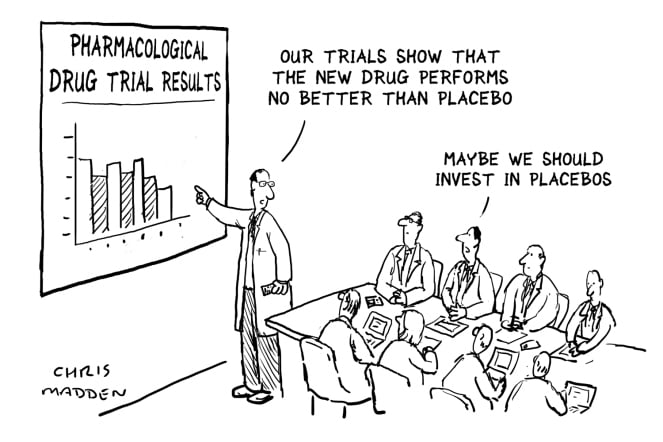No one can argue how powerful our minds are. We’re all very much aware of how mindset influences our reaction to interventions, both medicinal and non-medicinal. Either something negative happens to us and a positive mindset gives us closure. Or in the case of what we’re going to be discussing here, we have beliefs and expectations of a specific medical intervention solving our problems…and then it does. Often, placebos work as a sort of medication in their own right, having an effect in sometimes up to 60 percent of patients. And in some cases, a placebo can be just as effective as traditional treatments.
The Power of a Placebo
What is the Placebo Effect?
Considered to be a medical phenomenon, the placebo effect is produced by a substance which is not the result of the substance itself. It’s any psychological or physical effect where the patient’s belief, or expectation, after treatment is that the placebo treatment is working. And it’s not limited to one health condition, it can affect a wide variety of ailments.
Placebos can exist in the form of a pill, injection, or surgery. The brain essentially convinces us that the treatment worked.
In the case of scientific research, placebos are commonly used in clinical trials to assess the effectiveness of a new drug. Some participants will receive the drug being evaluated and others will take something like a sugar pill. Any effects shown by the placebo group will be compared against those who receive the real medication. And drugs are only proved to be successful if it generates a stronger, more measurable effect than the placebo.
We’re pretty familiar with the placebo effect in human medicine at this point. And whether or not placebos are a failure or success for humans is up for debate.
There is something to be said about how powerful our brains are at convincing us that a certain treatment is making us feel better. Nonetheless, is it really changing the root of the condition we want to address? After all, humans are notoriously good at persuasion, self-deception, and setting expectations. And that brings us to the placebo effect and our dogs.

Can our dogs hold certain beliefs and expectations about a treatment working or not?
Well…not really. But that’s where you potentially might enter into the equation. There’s no such thing as a placebo effect in animals because our dogs can’t truly know to what extent a treatment can work or not. Despite having our pet’s best interests at heart, this can leak into positive projections and warped understandings on how they may be reacting. This is where the caregiver placebo effect comes in. A placebo by proxy if you will. And yes, it’s a real thing.
The ‘Caregiver Placebo Effect’ as a dog owner
So here’s the thing about owning a dog, or any pet for that matter—we only want to do what’s best for them. To see them suffer is painful. That’s why, if there’s something that we believe can provide them relief, we’ll administer it with that hope and expectation. This is the caregiver placebo effect at play. Dogs can’t verbally tell us how they feel. They don’t really grasp what medication is, nevermind how it’s supposed to help them. But pet owners definitely do. And it’s pet owners and veterinarians that will be merely observers in the changes (or absence of) experienced by dogs undergoing a treatment.
When you’re evaluating the effectiveness of a drug or supplement your dog is taking—the caregiver placebo effect takes place if you’re perceiving an improvement in behavior or symptoms when there is none.
There are studies that have looked closer at this phenomenon of veterinary medicine. This study, in particular, assessed the lameness of 58 dogs that were taking a placebo. It discovered the extent to which the caregiver placebo effect takes place, and the results were alarming. 50 percent of the owners stated their dog’s lameness decreased during the study, 40 percent evaluated no change and 10 percent claimed their dog’s pain had gotten worse. When measuring how much the placebo effect took place, it was in 40 percent of owners and 40 to 45 percent of the veterinarians also evaluating the same dogs.
Let’s face it, dog owners (and vets!) are very invested in the health progress of their dogs, pinpointing every change based on what we know about our dogs, paired with what we believe and want to be happening from a treatment. In other words, we’re biased when it comes to our furry friends. This doesn’t mean that the improvements we observe aren’t all there. The problem is—this can potentially mislead what’s actually occurring.
Observing the effects of CBD in our dogs:
does CBD oil really work?
Maybe you’re at wits end trying to help end the suffering your dog is enduring. You’d try anything and everything to help aid any painful symptoms or side effects of a health condition. And perhaps, you’re considering to try CBD oil for dogs to treat your pup’s condition.
CBD is a bit of a breakthrough in the pet health world. It’s still seen as a little controversial due to a scarcity in medical research, but that doesn’t mean there isn’t any, or that CBD is not effective. In fact, there are both scientific studies and anecdotal testimonials on CBD for dogs that have shown positive results dogs suffering from various health ailments. And while a lot of it has revealed promising results, knowing about the caregiver placebo effect should make us extra cautious about holding up any treatment as full-proof.
When it comes to CBD’s impact on our dogs, your own perceptions of its effectiveness could accidentally make or break your dog’s treatment. It should also be noted that vets are not above this either. If a vet believes that CBD works or vice versa, they could also project those biases onto their observations in your dog.
All this being said, CBD oil remains in the early stages of discovery and research. It’s a little too soon to give sweeping definitive generalizations on CBD’s role in dog health. However, to completely dismiss the consistent remarks and evidence of CBD’s ability to alleviate pain and suffering would also be foolish. After all, we don’t want to cross the line of invalidating personal experiences. Still, how we feel about our dog’s situation after taking CBD can possibly create a cloud of illusion over the reality of its effects.
The harmful implications of projecting expectations on our pets
Listen, we understand the anguish of seeing your pet in pain. It’s normal to be optimistic and hope that a treatment will make your pet feel better. To see our playful pups at their best and spunkiest is probably one of our greatest sources of joy and love. It’s up to us as their owner to be their biggest advocate and sometimes that means interpreting how they’re feeling based on observing their patterns, habits, and behaviors. But without the ability to be able to directly communicate verbally with our pets, this becomes an inevitable blindspot in our caregiving. That even though we have good intentions and wishful thinking, it can do more harm than good if the treatment or medication isn’t actually working.
Dr. Alex Avery, a veterinarian, has written about the caregiver placebo effect. As he compassionately and truthfully states:
“Because we are so invested in our pet, we really want to see them improve and likely believe the treatment will work. We, as the pet owner, are highly susceptible to caregiver placebo as a result.”
He continues…
“There is a real risk we will see improvement even when it is not there.”
And the reverse can also be true.
We might have low expectations or belief that a treatment may actually work. And in this case, we wouldn’t see any development transpire. In some instances or conditions, pets could simply be improving naturally, medication aside. Knowing this, is there any way to prevent these unconscious biases from occurring?
How to counter the Caregiver Placebo Effect in dogs
For now, there’s not much information for owners on how to counter the caregiver placebo effect on their own. As a matter of fact, supporters of any treatment can fall into the trap of the placebo effect and stand behind the treatment’s effects on their pets.
And the truth is, without an objective measurement, none of us are immune from making inaccurate judgments based on what we believe or hope. So what can we do? The following methods are some ways that pet owners and the veterinary world can avoid these unconscious biases.
Double-blind scientific studies
One might think that hard evidence comes from scientific research, but only if that research goes through its own checks and balances. One main way to do this is through a double-blind study. This means that neither the researchers nor the participants know who is receiving any one specific treatment. There needs to be one group (control group) that receives a placebo instead of the actual medication.
In contrast, a single-blind study occurs when the researchers are aware of which participants are receiving the treatment they’re trying to study. But this is a potential slippery slope that puts researchers at risk of the caregiver placebo effect.
So in the case of CBD oil for dogs, a double-blinded study would need to have some dogs receive hemp oil while others receive a placebo oil. This study in particular is a good example. Researchers wanted to assess the safety and efficacy of CBD oil in dogs with osteoarthritis. To do this they administered 2 mg/kg of CBD oil to one group of dogs and placebo oil to another group every 12 hours for 4 weeks with a 2-week washout period. The final results indicated that 2mg/kg of CBD twice daily can increase comfort and activity in dogs with osteoarthritis. And this outcome is corroborated even more in light of it being double-blinded.
The caregiver placebo effect is not just limited to alternative therapies. Because the regulation of veterinary medicine is a bit less moderated than one might expect, very few veterinary studies have included a placebo group, which then puts other common treatments at risk of being less effective than we actually believe.
A double-blind study accomplishes two things:
When a study is conducted double-blinded, then we can be more sure of the reliability in the final results.
Objective healing measurements
This is the antithesis of how we might be used to evaluating our dog’s health and noticing improvements. But it’s important to tread lightly on subjectively deciding if your dog has progressed. Observe and make note of the symptoms you notice, but don’t take it all as evidence that the treatment is necessarily improving their condition. Some symptoms may waver and can’t always be easily measured with tests. These subjective measures of health include appetite, pain, and activity level.
Remain as detached and objective as possible when assessing any presence of changes, or no changes at all. Have someone who is aware of the power of the placebo effect and can consistently assess progress in an objective way—ideally this is your veterinarian. Start by documenting objective indicators before putting your pet on any new medication and then compare new results to those indicators. It’s critical to use more baseline objective measures to gauge the efficacy of CBD or any new supplement. More objective measurements of assessment include hormone levels, blood pressure, and blood sugar. But your vet will be able to specifically identify the areas that need to be assessed depending on your dog’s specific condition.
This can identify small improvements so you’re not discouraged, but also not coloring progress in any way. Oh…and no need to micro-watch every single move your dog makes. This only puts a microscope on our subjective measures of improvement.
Final Thoughts
CBD is still shiny and new. While it’s revealing a lot of promising health and therapeutic benefits for dogs, we have to be careful not to see improvement in our dogs where it doesn’t exist. We can’t always 100% trust anecdotes or our biased observations. After all, nobody wants to see their pet in better condition than an owner.
Going back to what we first said in the beginning, placebos can be very effective in alluding us to believe that our symptoms are going down. But when it comes to our pets, it’s typically just misguided. Don’t take every noticeable, immediate change at face-value. When introducing your dog to CBD, take it easy and slow, understanding that we don’t know everything about it yet.
Next read: 10 Best CBD Oils for Dogs



